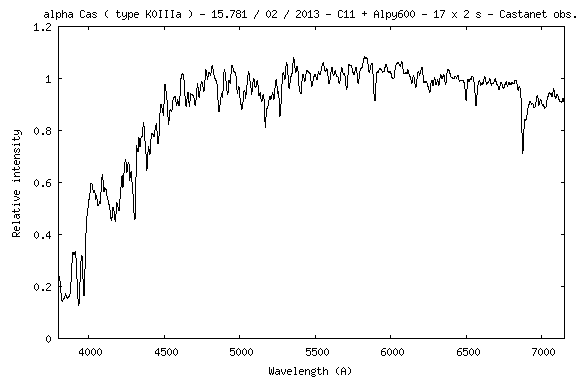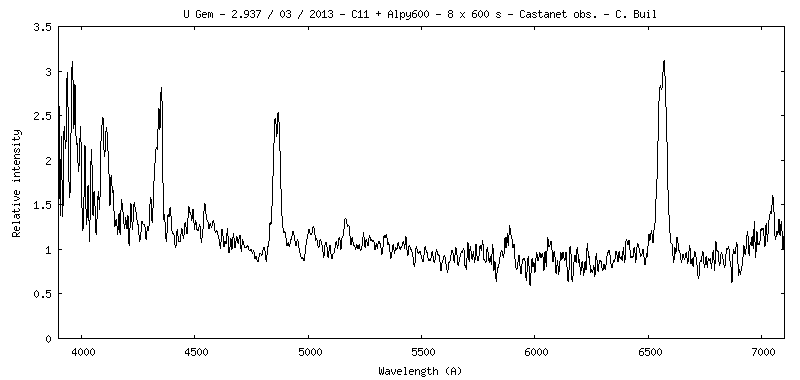



|
Alpy 600 spectrograph First results Christian
Buil |
|
Introduction |
Alpy 600 is a new spectrograph from Shelyak Instrument company. This page shows an overview of the first spectra obtained with this system. Here are some characteristics of the spectrograph: - Very compact and lightweight. More about performances of Alpy 600 spectrograph here. |
|
|
|
|
|
|
Some typical stellar spectra taken with Alpy 600.
|
On the left, the exterior aspect of base module. The size is similar to a simple telescope eyepiece. At the center, we can see a set of interchangeable slits (given in the standard configuration). On the right, a slit etched on a reflective substrate supplied with the guide optional module. For the scale, the Alpy 600 spectrograph is coupled to an ATIK 460EX CCD camera.
The base module interfaced to a flip-mirror system.
The optional high quality guiding system, recommended for advanced observations. The guiding camera is here an Atik314L+, but you can also choose any other model (low cost CCD, video camera, ...).
Alpy 600 can be used at the direct focus of fast modern refractors (apochromatic), at the f/10 focus of SCT telescope, and more... Here we use a standard SCT focal reducer to observe at f/6.5 (better luminosity, less sensitivity to seeing and guiding error).
The optional calibration module is added in front the guiding module (the white box). A simple 12 V power is required. ALPY600 system is presented here in its most complete configuration. |
|
The most
economical disposition for
Alpy 600.
The base
module is attached to the telescope from
a standard 31.75
mm interface. A flip mirror help to find and center
objects on the spectrograph entrance aperture (hole or slit). |
|
The guiding module
|

|
On the left, we
have the image delivered by the guiding
module. The camera used for this
function is here
an Atik314L +, a solution quite
luxurious, but also
very efficient. Use of more economical
camera is possible, of course. The vertical line is the image of entrance slit.
The slit size is 23 microns x 3 millimeters. Note the
excellent image quality provided by the system, a very
important point for accurately guiding and
identifying faint objects.
On the
right, the corresponding image of Messier 42
spectrum . The presence of a grism in the Alpy
600
system induce a
slight curvature of the spectral lines (corrected
during processing). The exposure time is 3 x 180 seconds with an
Atik460EX camera model (driven by Audela software). Some
sky pollution lines are visible, merged to M42 spectrum (click
here for identify spectral
lines).
The corresponding calibrated spectral profile. Note the UV part of the spectrum and thanks also to high UV sensitivity of Sony ICX694AL CCD detector (camera Atik460EX). The calibration module The Alpy 600 system can be completed by a calibation optional module, whih three functions: 1 - Ar/Ne/H lamp for spectral calibration
; Remote control is possible.
Spectral calibration spectrum delivered by the module (Ar/Ne/H spectrum).
|
|
Slit or Slitless Alpy
600 system
provides the
ability to observe
in two very different
modes: - A slitless mode (or quasi-slitless mode). This is the most economical solution. Example, you can use a simple flip-mirror to center the target. But the resolution is a function of focusing quality or seeing, not ideal for a scientific work. In addition, the sky brightness limits the ability to observe faint objects. Finally, for routine observations, the operability is relatively tedious. - A narrow slit mode (currently 23 microns). This forces the adoption of Alpy optional guiding module. The advantage is that the spectral resolution is now limited by the slit and not the seeing, it is possible to calibrate more precisely, and faint objects are more accessible.
|
| Slit and slitless modes: variation around NGC 2392 planetary nebula
NGC 2392 spectrum taken with LISA spectrograph and a Celestron 11 f/6.4
telescope. Exposure 15 x 300 seconds.
A typical faint surface object observation
|
|
Science: Variable stars survey |

Nova
Cephei 2013 at V = 13.1, 2013 Feb. 15.7.

Cataclysmic star U Gem in quiescent state at V = 14.5 (magitude source AAVSO).

Cataclysmic star
BT Mon at V = 15.2 (source AAVSO).

Symbiotic star TX CVn at V = 9.9

Symbiotic star V694 Mon at V = 10.5
And now a collection of MIRA and carbon stars...
|
|
|
|
|
|
|
|
|
|
|
|
|
Teach astronomy: Data acquisition and methods for an educational project
Example #1: Stellar
chimical composition (measure of metallicity)
Example #2: Redshift
measurement. The quasar 3C273 is a very easy object with a moderate
sized telescope.
Example #3: Extragalactic astronomy. Observe active galaxies, supernovae and measure Univers expension.
Example #4: Observation of atmospheric refraction. The observed objet (HD73495) is at low elevation relative to horizon (20.1°). Note the cuvature of the spectra (the atmosphere act as a dispersive element, i.e. blue rays are more deviated then red rays).
|